The AMD Radeon VII Review: An Unexpected Shot At The High-End
by Nate Oh on February 7, 2019 9:00 AM ESTProfessional Visualization and Rendering
With AMD strongly pushing the Radeon VII as a prosumer content creation card, it behooves us to look at rendering, CAD, and professional visualization performance. However, accurate and applicable benchmarks for this field are not so easy to find, especially since performance is highly dependent on workflow and proprietary licensed ISV software. Given AnandTech’s audience, which often includes engineers using these applications in critical production environments, our goal is to provide the most relevant metrics. However, as Ian has discussed previously, the route to the most accurate workstation benchmarking for professional applications is in the hands of ISVs, who are at best blasé and more typically negative about providing access, even at the prospect of lending limited software licenses in return for ongoing discussion and third-party benchmark data of their software.
Those caveats in mind, the next best thing for evaluating overall GPU workstation performance is the venerable SPECviewperf, recently updated to version 13. Separated into ‘viewsets,’ which are a group of application-specific workloads derived from real-world datasets, SPECviewperf has been a longstanding suite for generalized workstation/CAD GPU performance. For SPECviewperf 13, the viewsets are based on:
- Autodesk 3ds Max 2016 (Nitrous DX11 driver)
- Dassault Systèmes CATIA V6 R2012
- PTC Creo 3 & Creo 4
- Geosurvey software, with workloads based on rendering techniques utilized by the open-source OpendTect seismic visualization application
- Autodesk Maya 2017
- Radiological (i.e. CT, MRI scans) rendering, with workloads using the Tuvok rendering core of the ImageVis3D volume visualization application
- Autodesk Showcase 2013
- Siemens NX 8.0
- Dassault Systèmes Solidworks 2013 SP1
While we didn’t have time for complete benchmarking of video editing/production software such as Adobe Premiere Pro CC, we will be looking to include that in the future.
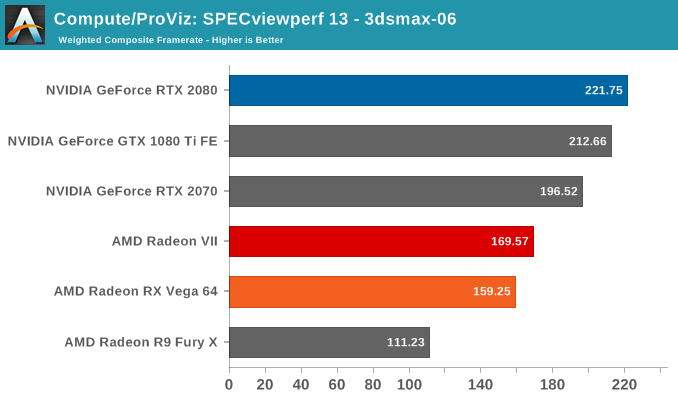
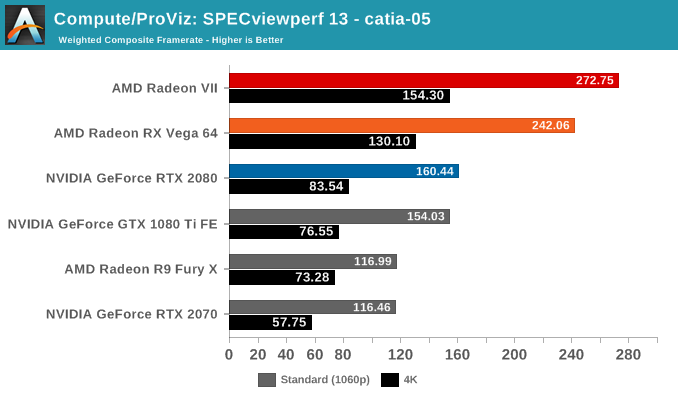

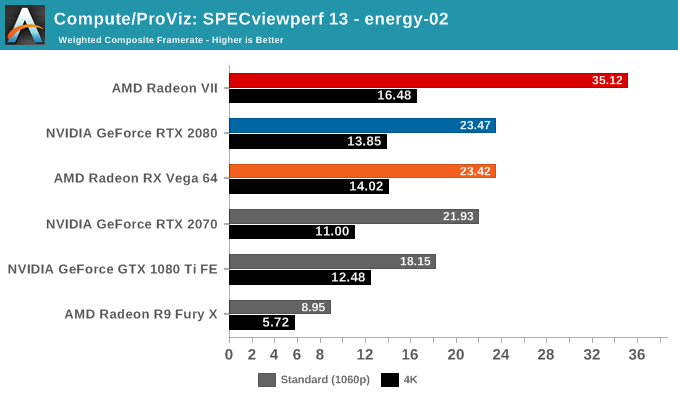
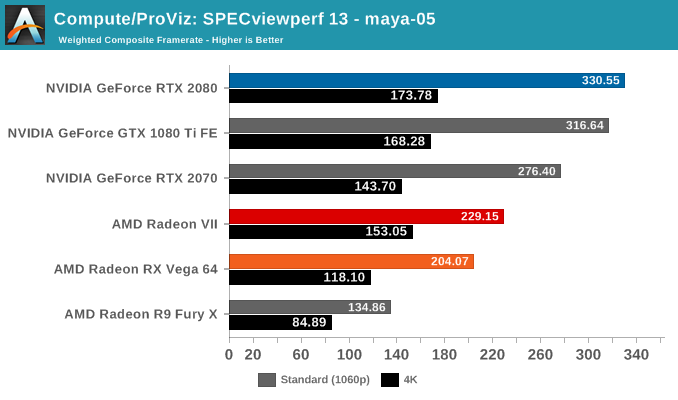
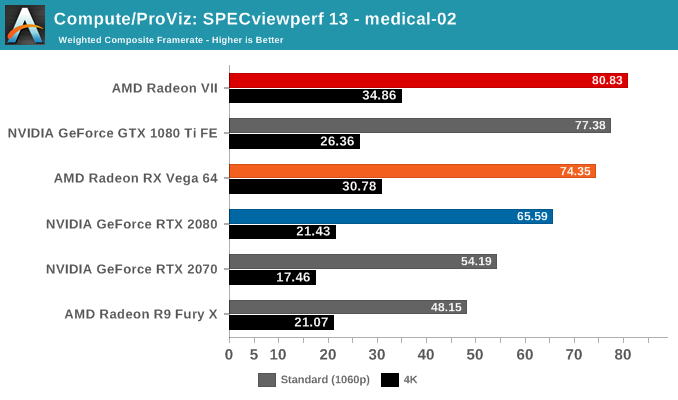
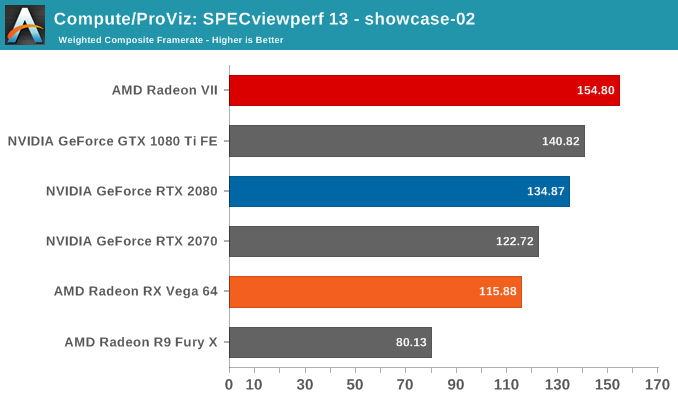
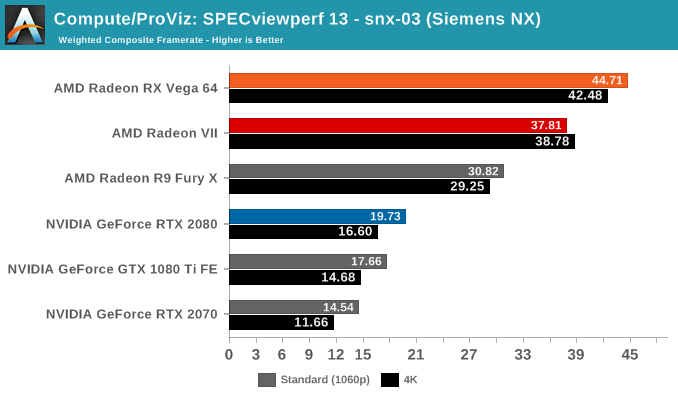
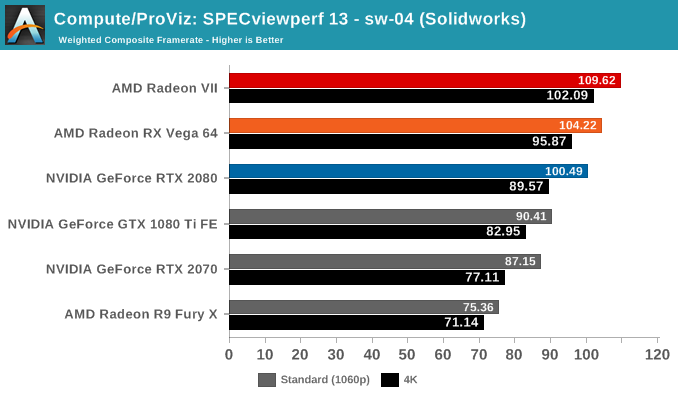
Looking over the results, it's clear that certain viewsets tend to perform better on one vendor's hardware than the other's. In those cases, the Radeon VII doesn't buck the trend, though in Siemens NX the lower performance is more likely than not related to driver maturity. In the reverse scenarios like in creo-02 or maya-05, the Radeon VII is in a similar spot, naturally ahead of the RX Vega 64 but behind the competing RTX and GTX cards. If anything, the results highlight the importance of software maturity for newer hardware, but there are definite signs of Vega 20 being a powerful workstation card. The caveat is that it doesn't seem to change the overall landscape for worksets that traditionally perform well on NVIDIA hardware.
Our next set of benchmarks look at rendering performance. To be clear, given the nature of ‘render wars’ as well as the adoption of CUDA, the featured render engines are not necessarily indicative of the overall GPU renderer landscape. Because we are looking at the Radeon VII, it’s not applicable to include some of the more popular renderers, such as Redshift and Octane, which are CUDA-only, and similarly the presence of Indigo Renderer helps as another datapoint even though it is less popular.


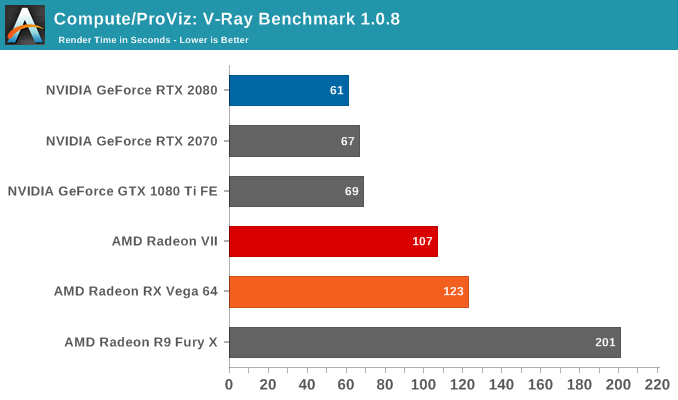

To note, official Blender releases have yet to incorporate CUDA 10, and so RTX 20 series cards are not officially supported.
V-RAY here is the only test that utilizes CUDA for NVIDIA cards, while the rest all use OpenCL. The results seem broadly similar to SPECviewperf, where the Radeon VII continues to excel at workloads where AMD hardware generally fare well.










289 Comments
View All Comments
Samus - Sunday, February 10, 2019 - link
BenSkywalker, the short answer is this is based on a dated architecture (2 generations behind Turing) so there is no real way it's going to beat it in efficiency: It doesn't even try to compete with the 2080Ti.But the fact that a GCN\Vega-based card can nearly tie a 2080 is commendable. I think the problem this card has is it's $100 too expensive.
BenSkywalker - Monday, February 18, 2019 - link
If we were comparing ray traced performance that would be a valid point, but we are talking about traditional rendering. They have a half node process advantage and are using more power than a 2080 by a comfortable amount.Try finding another chip, CPU or gpu that was built with a half node advantage, used more power *and* was slower.
Either TSMC is having major problems with 7nm or AMD set a new standard for poor engineering in this segment.
Ganjir - Saturday, February 9, 2019 - link
It is a shame the infinity fabric is disabled, because crossfire would actually give these cards a reason to use ALL of that bandwidth and capacity - at least on one card. Is there a way to enable this or is it a hardware limitation?Alistair - Saturday, February 9, 2019 - link
I calculate OxfordGuy has made 11 percent of all comments in this thread ;)Zingam - Sunday, February 10, 2019 - link
AMD should invest in power stations. And maybe even sell their future Radeon XIV in a bundle with a little power station!Crion66 - Sunday, February 10, 2019 - link
Nate or Ian, can AMD choose to enable pci-express 4.0 on this card when Ryzen/TR4 3000 is released?Also can crossfire be implemented by popular gamer demand?
ccfly - Tuesday, February 12, 2019 - link
did anyone test this card in c4d ,radeon pro vs octane for speed ?peevee - Tuesday, February 12, 2019 - link
"Though AMD hasn’t made a big deal of it up to now, Vega 20 is actually their first PCI-Express 4.0-capable GPU, and this functionality is enabled on the Radeon Instinct cards. However for Radeon VII, this isn’t being enabled, and the card is being limited to PCIe 3.0 speeds"Oh God, how much I hate marketoids! Morons who cannot get an A even in the primitive school math are hired into marketing depts, and ruin EVERYTHING.